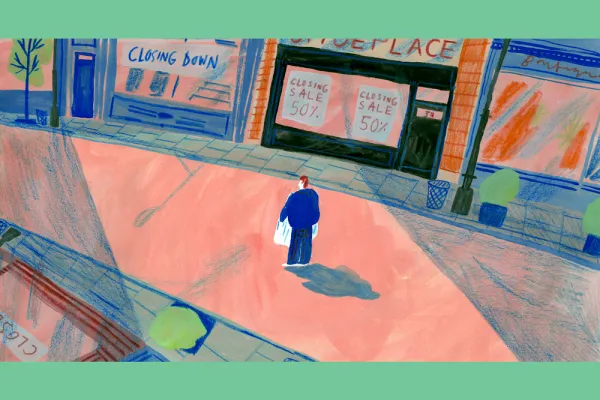‘The Centers of Commerce Suddenly Shifted’
Alum News

Published July 7, 2021
Melissa Noonan ’96 has extensive experience in the retail industry—she’s worked for Tiffany & Co. and TheRealReal (a luxury consignment website). She is currently vice president of manufacturing for the high-end home décor studio Apparatus. Here she talks about the state of retail before and after the pandemic, and the industry’s uncertain future.
Retail is at a crossroads. Before the pandemic, traditional department stores had been struggling for a long time and many malls were already a ghost town. There had been a lot of expansion in the early 2000s and luxury goods were everywhere, but by last year a lot of that had diminished. Traditional ad campaigns had to change their strategy, and some turned to influencer marketing—a type of social media marketing that uses “influential” people who have a strong social following to endorse products. Yet it was still unclear whether the huge fees paid to social media influencers were resulting in more sales.
WHEN THE PANDEMIC HIT
Many aspects of retail, manufacturing and distribution cannot be done remotely, so the pandemic was a massive upset—and each city and state established different rules for workers and customers. The centers of commerce suddenly shifted—Rockefeller Center was empty and still is. The weekday office shoppers, weekend shoppers, and tourists have disappeared. The fashion industry was turned on its head, and it’s unclear how that’s going to look in the future, which will affect retail store buyers. The pandemic forced businesses to look for creative solutions to maintain contact with customers.
THE BIG WINNERS
Besides Amazon and Walmart, the “winners”—companies that were the most successful during the pandemic—were those that had already established e-commerce with easy-to-use platforms for transactions and consolidated inventory hubs that were able to ship quickly. Customers needed easy, quick, and contactless ways to purchase products, and the most successful businesses were those that could meet that need. Many sectors related to home goods did well—leisure wear, skin care, interior products. Winners also included brands that promoted conversations around sustainability and social justice.
THE BIG LOSERS
Malls and department stores—any businesses that had a lot of debt— were the big losers. Major brands that couldn’t adjust quickly to the pandemic did not do well, and that resulted in a slew of bankruptcy filings, such as JC Penney, Brooks Brothers, Ann Taylor, Lucky Brand, Neiman Marcus and J. Crew. Brands that were already highly leveraged going into the pandemic—some of which were already looking for buyers and dependent on brick-and-mortar sales—also did not do well.
THE FUTURE OF BRICK AND MORTAR
Most brands, even with healthy balance sheets, have made major changes to their retail store footprint—closing stores, reducing capacity, shifting projected sales from the retail channel to online. There is a real emphasis on supply logistics and customer experience/service. Store locations are going to change, since it is unclear whether people will be returning to the office, and what that will mean for city stores.
THE SEAMLESS SUPPLY CHAIN
In the future, I think there will be more attention placed on inventory flexibility and supply-chain risk assessment to ensure that products will go from the manufacturer to the customer quickly and seamlessly. Companies want to know that if one warehouse or retail location is closed there isn’t a disruption to the whole chain— that they can easily move product from another location into the hands of the customer.
THE FUTURE IS ALL ABOUT VALUE AND VALUES
The fate of traditional retail and fashion industries is really up in the air. Brands that are value- or purpose-driven are not going away. The role of influencer is being refined. Partnerships and collaborations are happening everywhere—and many times they speak to customers’ values or involve designers that customers admire. People are careful where they spend their dollars because they want a product they believe in from a company with integrity. And businesses who can tap into that will be successful.
This story appears in the Summer 2021 issue of the Smith Alumnae Quarterly.
Read More Smart Ideas for a Post-Pandemic World
Nature: Simran Sethi ’92, ‘The Health of Our Population Depends on the Health of the World’
Health Care: Kimberly McGill ’01, ‘Systemic Racism Has Made This Pandemic the Crisis That It Is’
Work: Dorie Clark ’97, ‘You Can’t Afford to Be Seen as Dispensable
Traditional ways to achieve success in the retail sector were evolving before the pandemic. Now everything is up in the air. Illustration by Joey Yu
